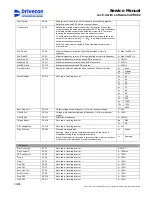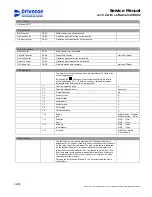
Service Manual
rev 5.0 with software Ind1V022
- Drive upwards at minimum speed for 5 to 10 seconds. Accelerate to full speed. Run 5 to 10 seconds.
Stop. Repeat the same in down direction. Check the frequency display to make sure that the frequency
changes through the whole operational frequency range from minimum to nominal speed.
-
Disconnect the signal wire coming from the pulse sensor to terminal X1:51. All the SSU faults will be reseted
automatically after one second when the pulses from the pulse sensor are missing
-
Drive with minimum speed. The motion must stop within set time.
-
Set rotary switch S1/S3 value 2 steps smaller
8.4 Test run with load
- Drive in both directions at minimum and maximum speeds.
- If the fan tube resistor unit is included, check that fan(s) starts to blow when driving down with nominal
load and continues to blow for about 4-5 minutes after stopping
8.3 Test run without load
- Make sure that movement will not cause any danger to the environment or to the crane itself. Avoid driving
close to the limit areas.
- Check limit switches manually if possible.
- Check the run commands on display panel and correct the drum rotating direction. The arrow rotates
clockwise if S1 (up) is applied and counter-clockwise if S2 (down) is applied.
- Check the function of the speed sensor, see chapter “Speed sensors”
- Check the function of the speed supervision circuit. See chapter "Functional test drive for SSU".
- Check motor operation (acceleration, deceleration and braking): accelerate to full speed up, change to full
speed down and full speed up again and stop.
- Check limit switch functions: drive up slowly and check the slowdown and stop limit switch operations. Re-
check using full speed. Repeat the same check for down direction.
- If the optional ESR is used, check the maximum frequency.
8.3.1 Functional test run for SSU
Note! Test run for SSU must be made without load.
-
Drive with maximum speed, the motion must stop at once
-
fault F62 (Speed difference) is activated
-
Reconnect the disconnected signal wire to terminal X1:51.
-
Drive with maximum speed. The motion must stop after full speed is reached.
-
fault F64 (Over speed) is activated
-
Set rotary switch S1/S3 back to original value.
- Note, three loads are required:
-
Nominal load (100%) for normal operation.
-
Limited load for ESR (optional).
-
An adequate extra load for dynamic overload testing and to test the ESR load limit.
- Make sure that movement will not cause any danger to the environment or to the crane itself.
- If the optional extended speed range (ESR) is used, check that the load limit is correctly set and hoisting
with bigger loads is prevented.
8.5 Test run with overload
If an overload test has to be performed during crane commissioning, minimum frequencies should be
risen for duration of the commissioning to 20Hz. Minimum frequencies can be changed with parameters
P2.2.8 and 2.2.9. After testing, minimum frequencies should be changed back to their original values.
8.6 After the test run
- Record all parameter value changes in the parameter list.
- Make sure all remarks and setting values are recorded.
- It is recommended to store the parameter settings in file User parameters, see chapter “User parameters”.
-
fault F63 (stall supervision) is activated
44/58
Drivecon Inc. reserves the right to alter or amend the above information without notice.
Содержание D2L
Страница 59: ......
















































